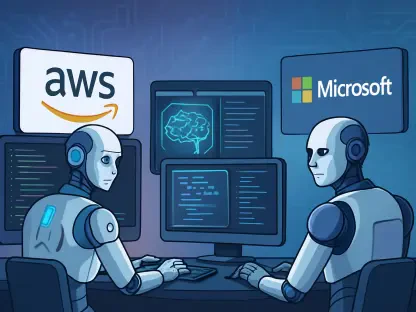The explosive growth of AI and machine learning applications has pushed traditional cloud computing systems to their limits, spawning a novel approach known as decentralized mesh hyperscalers. In this evolving scenario, developers witness a shift away from centralized systems, navigating toward mesh networks that promise greater scalability and resilience. This emerging form of architecture redistributes computing tasks across multiple interconnected nodes, ideally situated closer to data sources. This technique reduces latency while enhancing efficiency and reliability in a variety of applications, from IoT to real-time processing scenarios.
The Fundamentals of Decentralized Mesh Computing Architecture
Decentralized mesh computing is rooted in the concept of autonomous node communication, where nodes interact independently and collaboratively without a central server. This setup ensures a dynamic and non-hierarchical operation, fostering a self-healing network—highly valued for its robustness and fault tolerance. Its applications extend to wireless communications and edge computing environments, adeptly managing efficient data exchange and task allocation. The ability to sustain operations without a centralized authority makes mesh computing an attractive model for cutting-edge technological landscapes.
Autonomous node communication not only facilitates direct data sharing but also enables nodes to participate actively in resource distribution, vital in scenarios demanding significant resilience. This autonomy is crucial to network robustness, especially when systems undergo dynamic changes or face anomalies. The inherent flexibility allows organizations to tackle challenges that central cloud models might struggle with, positioning decentralized mesh computing as a formidable contender in modern AI environments.
A Deep Dive into Distributed Data Processing
The heart of decentralized mesh computing lies in distributed data processing, which divides workloads across a broad spectrum of interconnected nodes. This method trims latency by enabling nodes to process data in closer proximity to its source, thereby enhancing system performance considerably. Applications leveraging this technology witness tangible improvements, notably in sectors requiring immediate data feedback, such as self-driving automotive technology.
Distributed data processing addresses many limitations prevalent in traditional architectures, including bottlenecks and delayed responses in time-sensitive tasks. For instance, AI-driven applications, rife with substantial data requirements, benefit greatly from mesh systems’ ability to process data locally. By mitigating congestion and conserving resources, mesh frameworks foster eco-friendly computing, aligning with global sustainability ventures prevalent in today’s tech industry.
Traversing the Emerging Landscape: Decentralized Mesh Computing Trends
Recent developments have unveiled fascinating advancements within decentralized mesh computing systems, as industry players increasingly gravitate toward more adaptive and versatile frameworks. The integration of advanced algorithms and enhanced connectivity protocols has paved the way for novel applications previously constrained by traditional cloud inefficiencies. As organizations explore untapped capabilities, shifts in industry behavior signal a robust future for mesh-oriented architectures.
Current consumer trends reflect an escalating demand for real-time, ubiquitous computing experiences, propelling mesh systems to center stage in technological innovation. Enterprises anticipate enhanced system agility and responsiveness, vital for AI-driven applications that thrive on immediate data processing. These strategic reorganizations hold promise for future breakthroughs and long-term transformation in various fields.
Real-world Implementations and Sector-specific Applications
Decentralized mesh computing is seeing increasing deployment across diverse industries, from smart cities to autonomous vehicle networks. Notable use cases demonstrate its prowess, including IoT networks facilitating vast data exchanges within intelligent infrastructure systems or edge computing achieving substantial gains in processing speed and efficiency. Such implementations highlight the transformative power of mesh systems, underscoring their viability in complexity-ridden environments.
Industries requiring constant, high-frequency data interaction find particular value in decentralized mesh setups. The ability to localize data computations reduces resource strain on central servers, ensuring more reliable outcomes in time-critical workflows. This adaptability proves beneficial in sectors where reducing operational latency directly enhances performance, positioning mesh systems as pivotal catalysts in contemporary technological evolutions.
Addressing Obstacles and Technical Challenges
Despite compelling advantages, decentralized mesh computing faces noteworthy challenges and limitations associated with its widespread implementation. Coordinating workloads across distantly located nodes necessitates sophisticated models that may prove cumbersome. Technical issues related to data synchronization and regulatory frameworks can hinder efficient execution, potentially diluting the technology’s anticipated benefits.
The complexity inherent in mesh systems demands comprehensive strategies to manage data consistency and optimal performance. Moreover, the nuanced regulations of different jurisdictions highlight the need for flexibility, prompting firms to weigh whether mesh systems’ robustness truly outweigh operational intricacies. Oversight in these domains can lead to inefficiencies and might impede the smooth operation of mesh infrastructures globally.
Strategic Outlook: Advancing Decentralized Mesh Computing
Looking ahead, decentralized mesh computing holds expansive potential for reshaping industry standards and societal impacts. Anticipated breakthroughs may emerge through refined optimization of node interactions and enhanced algorithmic capabilities that bolster efficient data handling. As businesses continue to adapt and evolve, balanced strategies are essential to capitalize on mesh computing advancements.
Future trajectories likely entail further refinement in underlying technologies, promising deeper integration with AI developments. Strategic engagements with mesh systems could revolutionize industries, fostering innovative applications and elevating technological capabilities across multiple sectors. Businesses must remain vigilant about these dynamics to harness mesh computing’s full potential.
Conclusion
This review underscored decentralized mesh computing as a formidable force pushing technological boundaries within cloud architecture. The insights provided emphasized its advantages in handling AI workloads, though it poses complexities that demand careful management. As the industry continues progressing, striking a balance between innovative prospects and straightforward operation will be key for its prospective success.
In summary, while decentralized mesh hyperscalers signify remarkable progress, they necessitate heightened sophistication beyond several businesses’ current scopes. Although certain organizations find mesh architectures economically favorable, they invoke intricate operational demands. Exploring ways to simplify complex implementations while retaining an innovative edge proves crucial for both futuristic developments and sustainable cloud transformations.









